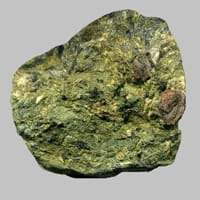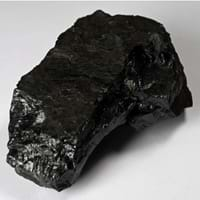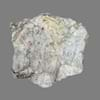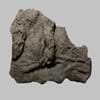Definition
Greenschist is a metamorphic rock that is formed under lowest temperatures and pressures and is usually produced by regional metamorphism
Coal is a combustible black or brownish-black sedimentary rock usually occurring in rock strata in layers called coal beds
Discoverer
Unknown
John Peter Salley
Etymology
From minerals such as chlorite, serpentine, and epidote, and platy minerals such as muscovite and platy serpentine which are green in color
From the Old English term col, which has meant mineral of fossilized carbon since the 13th century
Class
Metamorphic Rocks
Sedimentary Rocks
Sub-Class
Durable Rock, Medium Hardness Rock
Durable Rock, Soft Rock
Group
Not Applicable
Not Applicable
Other Categories
Coarse Grained Rock, Fine Grained Rock, Medium Grained Rock, Opaque Rock
Coarse Grained Rock, Fine Grained Rock, Medium Grained Rock, Opaque Rock
Texture
Foliated, Platy
Amorphous, Glassy
Color
Dark Greenish - Grey, Green
Black, Brown, Dark Brown, Grey, Light to Dark Grey
Durability
Durable
Durable
Appearance
Layered and Shiny
Veined or Pebbled
Interior Uses
Bathrooms, Countertops, Decorative Aggregates, Entryways, Homes, Interior Decoration
Not Yet Used
Exterior Uses
As Building Stone, As Facing Stone, Paving Stone, Garden Decoration, Office Buildings
Not Yet Used
Other Architectural Uses
Curbing
Not Yet Used
Construction Industry
As Dimension Stone, Building houses or walls, Cement Manufacture, Cutting Tool, for Road Aggregate, Roadstone
Cement Manufacture, for Road Aggregate, Making natural cement, Steel Production
Medical Industry
Not Yet Used
Not Yet Used
Antiquity Uses
Artifacts
Artifacts
Commercial Uses
Blackboards, Manufacture of tools, Writing Slates
Alumina Refineries, Electricity Generation, Liquid Fuel, Manufacture of Soap, Solvents, Dyes, Plastics and Fibres, Paper Industry
Types
Not Available
Peat, Lignite, Sub-Bituminous Coal, Bituminous Coal, Anthracite, Graphite
Features
Easily splits into thin plates, Smooth to touch
Helps in production of Heat and Electricity, Used as fossil fuel
Archaeological Significance
Monuments
Not Yet Used
Not Yet Used
Famous Monuments
Not Applicable
Not Applicable
Sculpture
Not Yet Used
Not Yet Used
Famous Sculptures
Not Applicable
Not Applicable
Pictographs
Used
Not Used
Petroglyphs
Used
Not Used
Figurines
Not Yet Used
Not Yet Used
Formation
Greenschist is medium grade metamorphic rock, formed by the metamorphosis of mudstone or shale, or some types of igneous rock, when it is subjected to higher temperatures and pressures.
Coal forms from the accumulation of plant debris in a swamp environment which is buried by sediments such as mud or sand and then compacted to form coal.
Mineral Content
Alusite, Amphibole, Biotite, Chlorite, Epidote, Feldspar, Garnet, Graphite, Hornblade, Kyanite, Micas, Muscovite or Illite, Porphyroblasts, Quartz, Serpentine, Sillimanite, Staurolite, Talc
Analcime, Apatite, Barite, Calcite, Chalcopyrite, Chlorite, Chromite, Clausthalite, Clay Minerals, Crandallite Group, Dolomite, Feldspar, Galena, Gypsum, Marcasite, Muscovite or Illite, Pyrite, Quartz, Siderite, Sphalerite, Zircon
Compound Content
CaO, Carbon Dioxide, MgO
Carbon, Hydrogen, Nitrogen, Oxygen, Sulphur
Types of Metamorphism
Not Applicable
Burial Metamorphism, Cataclastic Metamorphism, Regional Metamorphism
Types of Weathering
Biological Weathering, Chemical Weathering
Not Applicable
Types of Erosion
Chemical Erosion, Coastal Erosion, Glacier Erosion, Sea Erosion
Not Applicable
Grain Size
Medium to Fine Coarse Grained
Medium to Fine Coarse Grained
Fracture
Conchoidal
Conchoidal
Porosity
Highly Porous
Less Porous
Luster
Shiny
Dull to Vitreous to Submetallic
Cleavage
Slaty
Non-Existent
Toughness
1.5
Not Available
Specific Gravity
2.5-2.9
1.1-1.4
Transparency
Opaque
Opaque
Density
2.8-2.9 g/cm3
1100-1400 g/cm3
Specific Heat Capacity
Not Available
Resistance
Impact Resistant, Pressure Resistant, Water Resistant
Heat Resistant
Deposits in Eastern Continents
Asia
Afghanistan, Bangladesh, Bhutan, China, India, Japan, Kazakhstan, Malaysia, Pakistan, Russia, Thailand, Turkey, Vietnam
Bangladesh, Burma, Cambodia, China, India, Indonesia, Kazakhstan, Malaysia, Mongolia, Pakistan, Turkey, Vietnam
Africa
Egypt, Ethiopia, Morocco, Nigeria, South Africa
Botswana, Kenya, Morocco, Mozambique, South Africa, Tanzania
Europe
Austria, England, France, Georgia, Germany, Italy, Liechtenstein, Monaco, Norway, Slovenia, Spain, Sweden, Switzerland
Belgium, Bulgaria, England, France, Germany, Greece, Hungary, Kosovo, Netherlands, Norway, Poland, Romania, Serbia, Slovakia, Slovenia, The Czech Republic, Ukraine, United Kingdom
Others
Not Yet Found
Not Yet Found
Deposits in Western Continents
North America
Canada, Costa Rica, Cuba, Mexico, Panama, USA
Canada, Mexico, USA
South America
Brazil, Colombia, Guyana
Brazil, Chile, Colombia, Venezuela
Deposits in Oceania Continent
Australia
New South Wales, New Zealand, Queensland
New South Wales, Queensland, Victoria
Greenschist vs Coal Characteristics
Though some rocks look identical, they have certain characteristics which distinguish them from others. Characteristics of rocks include texture, appearance, color, fracture, streak, hardness etc. Greenschist vs Coal characteristics assist us to distinguish and recognize rocks. Also you can check about Properties of Greenschist and Properties of Coal. Learn more about Greenschist vs Coal in the next section. The interior uses of Greenschist include Bathrooms, Countertops, Decorative aggregates, Entryways, Homes and Interior decoration whereas the interior uses of Coal include Not yet used. Due to some exceptional properties of Greenschist and Coal, they have various applications in construction industry. The uses of Greenschist in construction industry include As dimension stone, Building houses or walls, Cement manufacture, Cutting tool, For road aggregate, Roadstone and that of Coal include Cement manufacture, For road aggregate, Making natural cement, Steel production.
More about Greenschist and Coal
Here you can know more about Greenschist and Coal. The life cycle of a rock consists of formation of rock, composition of rock and transformation of rock. The composition of Greenschist and Coal consists of mineral content and compound content. The mineral content of Greenschist includes Alusite, Amphibole, Biotite, Chlorite, Epidote, Feldspar, Garnet, Graphite, Hornblade, Kyanite, Micas, Muscovite or Illite, Porphyroblasts, Quartz, Serpentine, Sillimanite, Staurolite, Talc and mineral content of Coal includes Analcime, Apatite, Barite, Calcite, Chalcopyrite, Chlorite, Chromite, Clausthalite, Clay Minerals, Crandallite Group, Dolomite, Feldspar, Galena, Gypsum, Marcasite, Muscovite or Illite, Pyrite, Quartz, Siderite, Sphalerite, Zircon. You can also check out the list of all Metamorphic Rocks. When we have to compare Greenschist vs Coal, the texture, color and appearance plays an important role in determining the type of rock. Greenschist is available in dark greenish - grey, green colors whereas, Coal is available in black, brown, dark brown, grey, light to dark grey colors. Appearance of Greenschist is Layered and Shiny and that of Coal is Veined or Pebbled. Properties of rock is another aspect for Greenschist vs Coal. The hardness of Greenschist is 3.5-4 and that of Coal is 1-1.5. The types of Greenschist are Not Available whereas types of Coal are Peat, Lignite, Sub-Bituminous Coal, Bituminous Coal, Anthracite, Graphite. Streak of rock is the color of powder produced when it is dragged across an unweathered surface. The streak of Greenschist is white while that of Coal is black. The specific heat capacity of Greenschist is Not Available and that of Coal is 1.32 kJ/Kg K. Depending on the properties like hardness, toughness, specific heat capacity, porosity etc., rocks are resistant to heat, wear, impact, etc.Greenschist is impact resistant, pressure resistant, water resistant whereas Coal is heat resistant.





